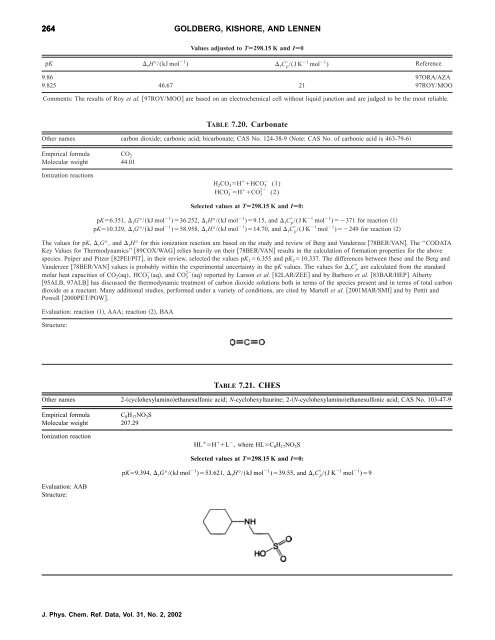Thermodynamic Quantities for the Ionization Reactions of Buffers
Thermodynamic Quantities for the Ionization Reactions of Buffers
Thermodynamic Quantities for the Ionization Reactions of Buffers
You also want an ePaper? Increase the reach of your titles
YUMPU automatically turns print PDFs into web optimized ePapers that Google loves.
264 GOLDBERG, KISHORE, AND LENNEN<br />
Values adjusted to TÄ298.15 K and IÄ0<br />
pK rH°/(kJ mol 1 ) rC p /(J K 1 mol 1 ) Reference<br />
9.86 97ORA/AZA<br />
9.825 46.67 21 97ROY/MOO<br />
Comments: The results <strong>of</strong> Roy et al. 97ROY/MOO are based on an electrochemical cell without liquid junction and are judged to be <strong>the</strong> most reliable.<br />
TABLE 7.20. Carbonate<br />
O<strong>the</strong>r names carbon dioxide; carbonic acid; bicarbonate; CAS No. 124-38-9 Note: CAS No. <strong>of</strong> carbonic acid is 463-79-6<br />
Empirical <strong>for</strong>mula CO 2<br />
Molecular weight 44.01<br />
<strong>Ionization</strong> reactions<br />
H 2CO 3H HCO 3 (1)<br />
HCO 3 H CO3 2 (2)<br />
Selected values at TÄ298.15 K and IÄ0:<br />
pK6.351, rG°/(kJ mol 1 )36.252, rH°/(kJ mol 1 )9.15, and rC p /(J K 1 mol 1 )371 <strong>for</strong> reaction 1<br />
pK10.329, rG°/(kJ mol 1 )58.958, rH°/(kJ mol 1 )14.70, and rC p /(J K 1 mol 1 )249 <strong>for</strong> reaction 2<br />
The values <strong>for</strong> pK, rG°, and rH° <strong>for</strong> this ionization reaction are based on <strong>the</strong> study and review <strong>of</strong> Berg and Vanderzee 78BER/VAN. The ‘‘CODATA<br />
Key Values <strong>for</strong> <strong>Thermodynamic</strong>s’’ 89COX/WAG relies heavily on <strong>the</strong>ir 78BER/VAN results in <strong>the</strong> calculation <strong>of</strong> <strong>for</strong>mation properties <strong>for</strong> <strong>the</strong> above<br />
species. Peiper and Pitzer 82PEI/PIT, in <strong>the</strong>ir review, selected <strong>the</strong> values pK 16.355 and pK 210.337. The differences between <strong>the</strong>se and <strong>the</strong> Berg and<br />
Vanderzee 78BER/VAN values is probably within <strong>the</strong> experimental uncertainty in <strong>the</strong> pK values. The values <strong>for</strong> rC p are calculated from <strong>the</strong> standard<br />
molar heat capacities <strong>of</strong> CO 2aq), HCO 3 aq, and CO3 2 aq reported by Larson et al. 82LAR/ZEE and by Barbero et al. 83BAR/HEP. Alberty<br />
95ALB, 97ALB has discussed <strong>the</strong> <strong>the</strong>rmodynamic treatment <strong>of</strong> carbon dioxide solutions both in terms <strong>of</strong> <strong>the</strong> species present and in terms <strong>of</strong> total carbon<br />
dioxide as a reactant. Many additional studies, per<strong>for</strong>med under a variety <strong>of</strong> conditions, are cited by Martell et al. 2001MAR/SMI and by Pettit and<br />
Powell 2000PET/POW.<br />
Evaluation: reaction 1, AAA; reaction 2, BAA<br />
Structure:<br />
TABLE 7.21. CHES<br />
O<strong>the</strong>r names 2-cyclohexylaminoethanesulfonic acid; N-cyclohexyltaurine; 2-N-cyclohexylaminoethanesulfonic acid; CAS No. 103-47-9<br />
Empirical <strong>for</strong>mula C 8H 17NO 3S<br />
Molecular weight 207.29<br />
<strong>Ionization</strong> reaction<br />
Evaluation: AAB<br />
Structure:<br />
J. Phys. Chem. Ref. Data, Vol. 31, No. 2, 2002<br />
HL H L , where HLC 8H 17NO 3S<br />
Selected values at TÄ298.15 K and IÄ0:<br />
pK9.394, rG°/(kJ mol 1 )53.621, rH°/(kJ mol 1 )39.55, and rC p /(J K 1 mol 1 )9
















